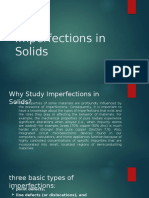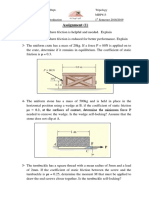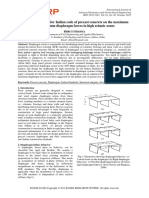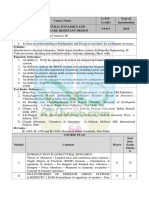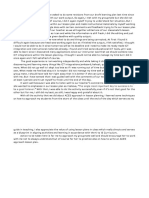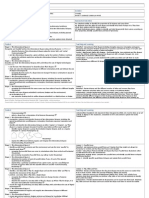General Chemistry 101
General Chemistry 101
Uploaded by
Najmul Puda PappadamCopyright:
Available Formats
General Chemistry 101
General Chemistry 101
Uploaded by
Najmul Puda PappadamOriginal Description:
Copyright
Available Formats
Share this document
Did you find this document useful?
Is this content inappropriate?
Copyright:
Available Formats
General Chemistry 101
General Chemistry 101
Uploaded by
Najmul Puda PappadamCopyright:
Available Formats
COLLEGE OF ARTS AND SCIENCES
Course Title
& Number CHM 101: GENERAL CHEMISTRY I
Pre/Co-requisite(s) NA
Number of credits 3-3-4
Faculty Name Mohammad Al-Sayah
Term/ Year Spring 2015
Sections
CRN Section Course Days Time Location*
20090 11 General Chemistry I MW 11:00-12:15 C-109
Location subject to change
Instructor
Information Instructor Office Telephone Email
Mohammad Al-Sayah C-118B X-2426 malsayah@aus.edu
Office Hours:*
Monday: 3:00-4:30 pm and Thur: 11:00 am-12:45 pm.
Or by appointment, if the office hours conflict with your scheduled classes
Office Hours will be posted on the office door.
Covers the fundamental chemical principles, concepts and laws. Includes the following topics:
Course
reaction stoichiometry, types of chemical reactions, solution stoichiometry, gas laws, kinetic
Description from
theory of gases, thermochemistry, atomic structure and periodicity, the Bohr model, Lewis
Catalog
structures, ionic and covalent bonding. Laboratory experiments illustrate principles discussed in
the course
Course Learning Upon completion of the course, students will be able to:
Outcomes describe the basic concepts of chemistry and the philosophy behind studying them,
explain the concept of the periodic table and the properties of different elements,
perform stoichiometry calculations and applying these to chemical reactions,
apply the ideal gas laws for calculations involving gaseous reactions,
describe the general concepts of thermodynamics and apply them to calculate enthalpy
and internal energy changes during any chemical reaction,
work out electronic configurations of the atoms and their consequences in interpreting
and predicting the properties of the atoms,
construct Lewis structures and predict molecular geometries,
conduct simple chemical laboratory experiments and write lab reports.
Chemistry, 11th edition, R. Chang and K. A. Goldsby, McGraw-Hill, 2013; ISBN:
Textbook and
9780071317870.
other Instructional
Material and Student Solutions Manual for Chemistry, 11th edition, R. Chang and K.A. Goldsby,
Resources McGraw-Hill, 2013; ISBN: 978-0077386542.
Chem Lab AUS, AUS Edition, J. Beran, John Wiley and Sons Inc., 2014; ISBN:
9781119918318.
Teaching and The course is based on class lectures and laboratory experiments. Class lectures are designed to
Learning help students develop problem solving skills and understand the material being emphasized in
Methodologies the textbook. Labs provide hands-on laboratory experience and illustrate concepts that are being
covered in the lectures. It is highly advisable, to get the most out of each lecture, that one always
read the appropriate sections before they are discussed in class. The reading assignments will be
announced during class time and homework will be posted on ilearn. You can access
Blackboard by typing ilearn.aus.edu
1
COLLEGE OF ARTS AND SCIENCES
Grading Scale, Grading Scale
Grading
Distribution, and 92 100 4.0 A 74 76 2.3 C+
Due Dates 88 91 3.7 A- 70 73 2.0 C
84 87 3.3 B+ 65 69 1.7 C-
80 83 3.0 B 60 64 1.0 D
77 79 2.7 B- Less Than 60 0 F
Grading Distribution
Assessment Weight Due Date
Laboratory 20%
Exam I Tues, March 24, 2015 at 5:00 pm
Exam II 50% Tues, April 21, 2015 at 5:00 pm
Exam III Tues, May 19, 2015 at 5:00 pm
Final Exam 30 % Sec 11: June 3, 2015 at 11:00 am
Total 100%
* Lowest grade exam is worth 10% and the other two are 20% each
Explanation of
This course consists of theoretical and laboratory parts, details of each component are listed
Assessments
below:
Laboratory: 3 contact hours, worth 20% of the final grade (8% for pre-labs and reports, 8% for
quizzes, and 4% for laboratory performance).
Theory: 3 contact hours per week, worth 80% of the final grade.
Attendance:
Students are required to abide by AUS regulations regarding attendance. A student should be in
the class before his/her name is called by the instructor, otherwise the student will be considered
Absent. The student will be force withdrawn from the course once he/she has five (5)
Absents on his/her record. If a student misses an exam due to illness, a valid medical report
should be submitted to the instructor no later than three days after the exam date. If the medical
excuse was acceptable, the grade will be obtained from the performance in other exams. A
grade of Zero will be given for any exam missed without an acceptable medical excuse. A
student will be dropped from the course once s/he has missed two exams, or two labs. There
will be NO makeup exams, quizzes or labs. All students are expected to strictly observe and
adhere to the standards of academic conduct as detailed in the Student Academic Integrity Code.
Mobile Phone
Students should ensure that mobile phones are switched off before entry to the classroom. If a
Policy:
mobile should ring while the class is in session, it could be impounded and held for a period of
time in the Chemistry Department office.
Student Academic Students MUST read the Student Academic Integrity Code outlined in the AUS Catalog
Integrity Code and agree to abide by the standards for academic conduct, students rights and
Statement responsibilities and procedures for handling allegations of academic dishonesty.
COLLEGE OF ARTS AND SCIENCES
COURSE CONTENTS:
A. Class Schedule
Note: Tests and other graded assignments due dates are set. No addendum, make-up exams, or extra assignments to
improve grades will be given.
#of 75-
min CHAPTER NOTES
lectures
2 01: Chemistry: The Study of Change
3 02: Atoms, Molecules, and Ions
3 03: Mass Relationships in Chemical Reactions
Exam I Chapters 1, 2 and 3
3 04: Reactions in Aqueous Solutions
05: Gases Section 5.8 not included
2 06: Thermochemistry Section 6.7 not included
3 Exam II Chapters 4, 5 and 6
07: Quantum Theory and the Electronic Structure of
2 Section 7.5 not included
Atoms
2 08: Periodic Relationships Among the elements Section 8.6 not included
3 09: Chemical Bonding I: Basic Concepts Sections 9.3 and 9.10 not included
Exam III Chapters 7, 8 and 9
10: Chemical Bonding II: Molecular Geometry and
3
Hybridization of Atomic Orbitals
Final Exam (30%) Comprehensive (All chapters)
COLLEGE OF ARTS AND SCIENCES
B. Lab Schedule
WEEK# CHAPTER NOTES
1 Feb 15-19 ----- Check in
2 Feb22-26 Lab Manual* Safety Rules & Fun Experiments
3 March 1-5 Expt.1 The Use of Volumetric Glassware
4 March 8-12 Expt.2 Density Determinations
5 March 15-19 Exp. # 7 Empirical Formulas (Part A and B only)
6 March 22-26 Exp. # 5 Percent Water in Hydrated Salt
7 March 29-April 2 Exp. # 9 A volumetric analysis
8 April 5-9 Spring Break
9 April 12-16 Exp. # 21 Hard Water Analysis (Part B)
10 April 19-23 Exp. # 31 Dissolved Oxygen Levels in Natural Waters
11 April 26-30 Exp. # 12 Molar Mass of a Volatile Liquid
12 May 3-7 Exp. # 25 Calorimetry (Part-B)
13 May 10-14 Exp. # 15 Synthesis of Potassium Alum (Part A)
14 May 17-21 Exp. # 28 Chemistry of Copper
17 May 24--28 ----- Reserved for experiments missed due to Holidays
* Lab Manual: Chemistry Lab Manual: AUS - Wiley Custom Edition by Beran
Disclaimer:
This syllabus has been carefully designed to deliver the courses learning objectives and outcomes to the students in a very clear,
comprehensive, coherent fashion. Although this syllabus is considered an educational contract between the professor and the students,
events of unpredictable, erratic nature may necessitate changes to scheduling of assignments, tests, essays, exams, and other course-
related exercises. The professor reserves the privilege of making changes to the schedule, although a huge effort will be made to avoid
introduction of such sporadic changes. In case of any changes, students will be notified in a timely fashion in class, via email, and/or
ilearn. This disclaimer does not, in any means, obliterate or conflict with students rights as described by the general rules and
regulations stated in the undergraduate catalog and established by the American University of Sharjah.
You might also like
- AP Biology Premium, 2025: Prep Book with 6 Practice Tests + Comprehensive Review + Online PracticeFrom EverandAP Biology Premium, 2025: Prep Book with 6 Practice Tests + Comprehensive Review + Online PracticeNo ratings yet
- Experiment 1B - Tubular ReactorDocument14 pagesExperiment 1B - Tubular ReactorNajmul Puda Pappadam100% (1)
- Lecture # 1, Introduction To Engineering Ethics, Chapter # 1, Mike MatinDocument50 pagesLecture # 1, Introduction To Engineering Ethics, Chapter # 1, Mike MatinFarhan AhmadNo ratings yet
- CME 301 - Mass Transfer Differential Equations of Mass Transfer Example ProblemsDocument9 pagesCME 301 - Mass Transfer Differential Equations of Mass Transfer Example ProblemsNajmul Puda PappadamNo ratings yet
- Diversity Lesson Plan TemplateDocument6 pagesDiversity Lesson Plan Templateapi-285015723No ratings yet
- Child Care 2 - Connection Between Reading and WritingDocument12 pagesChild Care 2 - Connection Between Reading and Writingrushie23No ratings yet
- TASK 2 CommentaryDocument3 pagesTASK 2 Commentarybrileinon57% (7)
- Building Construction - Lecture Plan For I Year B SectionDocument3 pagesBuilding Construction - Lecture Plan For I Year B Sectionparul vyas0% (1)
- Thermal ExpansionDocument3 pagesThermal ExpansionSenang Orang100% (1)
- Corrosion Assignment-2018Document2 pagesCorrosion Assignment-2018Huy An Mai0% (2)
- Corrosion PreventionDocument2 pagesCorrosion Preventionandrew myintmyatNo ratings yet
- Final Exam Key AnswerDocument6 pagesFinal Exam Key Answergirma worku100% (1)
- Machine DesignDocument128 pagesMachine Designshivani joshi100% (1)
- Lecture - 04 Bolted ConnectionsDocument57 pagesLecture - 04 Bolted Connectionssaleemm_2No ratings yet
- Iare - Ce - Iwwt - QB 2 PDFDocument7 pagesIare - Ce - Iwwt - QB 2 PDFB MehaboobNo ratings yet
- Lab 6 Wastewater Treatment PDFDocument17 pagesLab 6 Wastewater Treatment PDFmyco samNo ratings yet
- UAE Professional Structural Engineer Test - RequirementsDocument3 pagesUAE Professional Structural Engineer Test - RequirementsMelekeenNo ratings yet
- Carbonation PaperDocument34 pagesCarbonation PaperShahin ShajahanNo ratings yet
- CET303 SyllabusDocument11 pagesCET303 SyllabusdipinnediyaparambathNo ratings yet
- Inspection and Testing of WeldsDocument22 pagesInspection and Testing of WeldsKamarul NizamNo ratings yet
- Imperfections in SolidsDocument36 pagesImperfections in SolidsRowEll CañEtaNo ratings yet
- Lecture 17-Chapter 12 - Ceramics and Polymer (I) PDFDocument10 pagesLecture 17-Chapter 12 - Ceramics and Polymer (I) PDFtaylor CNo ratings yet
- Effects of Nano-Silica On Slag Based Geopolymer: A Project Report Submitted byDocument52 pagesEffects of Nano-Silica On Slag Based Geopolymer: A Project Report Submitted byNa oo Saki GarodNo ratings yet
- CE+4042 Reinforced+Concrete+Design Tuala 2023Document6 pagesCE+4042 Reinforced+Concrete+Design Tuala 2023Edgiecylin Blessy GalenoNo ratings yet
- Types of Electrochemical CorrosionDocument10 pagesTypes of Electrochemical CorrosionAaka Sh100% (1)
- A Partial View of Japanese Post-Kobe Seismic Design and Construction PracticesDocument11 pagesA Partial View of Japanese Post-Kobe Seismic Design and Construction PracticesHelen WangNo ratings yet
- Tribology Assignment 01Document3 pagesTribology Assignment 01AhmedAhmed100% (1)
- Chapter 0 ContentDocument6 pagesChapter 0 ContentbsitlerNo ratings yet
- Fundamentals of Deformable Bodies - INTRODocument17 pagesFundamentals of Deformable Bodies - INTROJor DanNo ratings yet
- WWW SefindiaDocument11 pagesWWW SefindiaSUSHANTBIJAMNo ratings yet
- CE-1 Civil Engineering OrientationDocument18 pagesCE-1 Civil Engineering OrientationLeandro DichosoNo ratings yet
- Lecture 1 IntroductionDocument21 pagesLecture 1 IntroductionKelvin Ken WitsNo ratings yet
- Sampe Paper For BiologyDocument7 pagesSampe Paper For BiologyMuhammad Usman Khan100% (1)
- Iwwt PPTDocument252 pagesIwwt PPTSelva Prakash100% (1)
- Lecture 1 - Intro To CMT & Considerations in Material SelectionDocument41 pagesLecture 1 - Intro To CMT & Considerations in Material SelectionKier Lorenz FernandezNo ratings yet
- International Journal PrecastDocument3 pagesInternational Journal Precastraghuveer11No ratings yet
- Lecture 3 Axially Loaded MembersDocument59 pagesLecture 3 Axially Loaded MembersCyrus HongNo ratings yet
- Seminar On Shear ConnectorsDocument37 pagesSeminar On Shear Connectorssanjaymits20% (1)
- Mechanics MCQsDocument17 pagesMechanics MCQsbaig79100% (1)
- Mini ProjectDocument8 pagesMini ProjectAzizul Hadi100% (1)
- Poultry Farm Bio SecurityDocument71 pagesPoultry Farm Bio SecurityShirley OcampoNo ratings yet
- Failure Studies in Materials - ch8Document47 pagesFailure Studies in Materials - ch8tamailhamNo ratings yet
- One-Tonne Carbon TreeDocument3 pagesOne-Tonne Carbon TreeArmando Rodriguez MontellanoNo ratings yet
- Engineering in Society (Ceng 291) : Abridged By: Nana Kwabena (Nkay)Document11 pagesEngineering in Society (Ceng 291) : Abridged By: Nana Kwabena (Nkay)Rebecca AsirifiNo ratings yet
- CE468 Structural Dynamics and Earthquake Resistant DesignDocument2 pagesCE468 Structural Dynamics and Earthquake Resistant DesignShahsad MohammedNo ratings yet
- Lecture 1 Introduction To Highway Pavement Construction 25.072023Document37 pagesLecture 1 Introduction To Highway Pavement Construction 25.072023Timothy MagikaNo ratings yet
- Shear and Bending Moment Diagrams - A ReviewDocument15 pagesShear and Bending Moment Diagrams - A ReviewNicole Ann PedriñaNo ratings yet
- Chemical Engineering: ReactionDocument58 pagesChemical Engineering: ReactionziaNo ratings yet
- EMAT FA1.1 - Q1.1 Ferrous and Non-Ferrous MetalsDocument3 pagesEMAT FA1.1 - Q1.1 Ferrous and Non-Ferrous MetalsUC MARE MARITIME SYLLABUS CDRC100% (1)
- Machine Element Design Chapter 1 (Diploma)Document25 pagesMachine Element Design Chapter 1 (Diploma)Ahmad Luqman Nurhakim100% (1)
- Research Trends in NepalDocument30 pagesResearch Trends in NepalDayaram Paudyal100% (1)
- Lecture Notes PDFDocument196 pagesLecture Notes PDFJasonSpringNo ratings yet
- Spontaneously Not Vice Versa: Second-Law - PPT Modified 10/9/02Document10 pagesSpontaneously Not Vice Versa: Second-Law - PPT Modified 10/9/02Sapari VelNo ratings yet
- Specifications For Various Civil Engineering WorksDocument28 pagesSpecifications For Various Civil Engineering WorksShahan DashtiNo ratings yet
- Introduction, Site Selection and Orientation PDFDocument16 pagesIntroduction, Site Selection and Orientation PDFIrshad AliNo ratings yet
- COKE W.M (Powerpoint)Document10 pagesCOKE W.M (Powerpoint)daabgchiNo ratings yet
- Introduction To CADDocument27 pagesIntroduction To CADAravind AakashNo ratings yet
- Comparative Study On Reinforced Concrete and Steel Framed Buildings With Various Floor Systems Tarique Nazmus SadatDocument197 pagesComparative Study On Reinforced Concrete and Steel Framed Buildings With Various Floor Systems Tarique Nazmus SadatsaifurNo ratings yet
- Title and Objective FormulationDocument6 pagesTitle and Objective FormulationchristianNo ratings yet
- Professional Engineering BookletDocument12 pagesProfessional Engineering BookletAlex CfkNo ratings yet
- A Research Project To Investigate The Effect of Automation in Banking ServicesDocument46 pagesA Research Project To Investigate The Effect of Automation in Banking ServicesAbhishek AggarwalNo ratings yet
- College of Arts and Sciences: 1. Sketch and Discuss Phase DiagramsDocument4 pagesCollege of Arts and Sciences: 1. Sketch and Discuss Phase DiagramsNajmul Puda PappadamNo ratings yet
- College of Arts and Sciences: CHM 215 Organic Chemistry IDocument3 pagesCollege of Arts and Sciences: CHM 215 Organic Chemistry INajmul Puda PappadamNo ratings yet
- 2019FA-Organic CHEM-2423-61310Document10 pages2019FA-Organic CHEM-2423-61310Lissette RegisNo ratings yet
- 2020SP Chem 2425 62400Document10 pages2020SP Chem 2425 62400Lissette RegisNo ratings yet
- Proper Engineering and Management Decisions: Functions of Engineers and ManagersDocument5 pagesProper Engineering and Management Decisions: Functions of Engineers and ManagersNajmul Puda PappadamNo ratings yet
- Experiment 3 - Fixed and Fluidized BedDocument12 pagesExperiment 3 - Fixed and Fluidized BedNajmul Puda Pappadam100% (2)
- Linear Equations in Linear Algebra: Row Reduction and Echelon FormsDocument31 pagesLinear Equations in Linear Algebra: Row Reduction and Echelon FormsNajmul Puda PappadamNo ratings yet
- Chap 3 Part 2 SlidesDocument10 pagesChap 3 Part 2 SlidesNajmul Puda PappadamNo ratings yet
- CME 200 Introduction To Chemical Engineering: Dr. Hadil Abu KhalifehDocument17 pagesCME 200 Introduction To Chemical Engineering: Dr. Hadil Abu KhalifehNajmul Puda PappadamNo ratings yet
- Introduction To Chemical Engineering CME 200 Dr. Hadil Abu Khalifeh Assignment 1Document7 pagesIntroduction To Chemical Engineering CME 200 Dr. Hadil Abu Khalifeh Assignment 1Najmul Puda PappadamNo ratings yet
- CME 301 - Mass Transfer Differential MT Equations For Unsteady-State Molecular Diffusion (USS-MD)Document24 pagesCME 301 - Mass Transfer Differential MT Equations For Unsteady-State Molecular Diffusion (USS-MD)Najmul Puda PappadamNo ratings yet
- CME 301 - Mass Transfer 1D Mass Transfer With 1 Order Homogeneous Chemical ReactionDocument11 pagesCME 301 - Mass Transfer 1D Mass Transfer With 1 Order Homogeneous Chemical ReactionNajmul Puda PappadamNo ratings yet
- Batch Distillation PracticeDocument17 pagesBatch Distillation PracticeNajmul Puda PappadamNo ratings yet
- CME 301 - Mass Transfer Convective Mass Transfer: Dr. Chandra Mouli MRDocument31 pagesCME 301 - Mass Transfer Convective Mass Transfer: Dr. Chandra Mouli MRNajmul Puda PappadamNo ratings yet
- CME 301 - Mass Transfer Lecture 2 - 2 2b. Differential Equations For Steady-State Molecular DiffusionDocument18 pagesCME 301 - Mass Transfer Lecture 2 - 2 2b. Differential Equations For Steady-State Molecular DiffusionNajmul Puda PappadamNo ratings yet
- Practice 2Document30 pagesPractice 2Najmul Puda PappadamNo ratings yet
- Continuous Distillation Practice 1Document35 pagesContinuous Distillation Practice 1Najmul Puda PappadamNo ratings yet
- Review Problems Chapt 25Document5 pagesReview Problems Chapt 25Najmul Puda PappadamNo ratings yet
- Chapter 1 - IntroductionDocument55 pagesChapter 1 - IntroductionNajmul Puda PappadamNo ratings yet
- Chapter 12 - Transient Response of Control Systems2019 UpdateDocument15 pagesChapter 12 - Transient Response of Control Systems2019 UpdateNajmul Puda PappadamNo ratings yet
- Don't Believe Everything You Think! Chapter 1Document17 pagesDon't Believe Everything You Think! Chapter 1Najmul Puda PappadamNo ratings yet
- Israeli Textbooks and Children's Literature Promote Racism and Hatred Toward Palestinians and ArabsDocument5 pagesIsraeli Textbooks and Children's Literature Promote Racism and Hatred Toward Palestinians and ArabsNajmul Puda PappadamNo ratings yet
- Revised ReflectionDocument2 pagesRevised Reflectionapi-591307095No ratings yet
- Diagnostic TestingDocument8 pagesDiagnostic Testingmumarbsc7244No ratings yet
- Concept Attainment Lesson Plan PDF Standard 8Document4 pagesConcept Attainment Lesson Plan PDF Standard 8Haley50% (4)
- Assignment 2 E-Portfolio 1Document2 pagesAssignment 2 E-Portfolio 1api-266898287No ratings yet
- Level C - All Kinds of BoatsDocument2 pagesLevel C - All Kinds of Boatsapi-352706779No ratings yet
- 2d Shapes Term 1Document3 pages2d Shapes Term 1api-277245562No ratings yet
- Trainer Instructional Designer in Central PA Resume Stephanie NagyDocument2 pagesTrainer Instructional Designer in Central PA Resume Stephanie NagyStephanieNagyNo ratings yet
- OME 2016 08 EGN 3365 Eng Materials 1 Presuel MorenoDocument3 pagesOME 2016 08 EGN 3365 Eng Materials 1 Presuel MorenoMadison CallowayNo ratings yet
- Micro TeachingDocument50 pagesMicro TeachingNimisha Beri100% (2)
- Course Curriculum Course Title: Sale Deed (Drafting and Registration) Course Code: LAW 469Document3 pagesCourse Curriculum Course Title: Sale Deed (Drafting and Registration) Course Code: LAW 469salman panwarNo ratings yet
- IXL - British Columbia Grade 6 Math CurriculumDocument6 pagesIXL - British Columbia Grade 6 Math Curriculumpkgarg_iitkgpNo ratings yet
- Syllabus - Entrepreneurial Management 2019Document6 pagesSyllabus - Entrepreneurial Management 2019api-194241825No ratings yet
- 3692 Sector Skills Additional Guidance v1Document413 pages3692 Sector Skills Additional Guidance v1elpiratamp3No ratings yet
- Task 9 NDocument4 pagesTask 9 Napi-295499489No ratings yet
- Lesson PlanDocument2 pagesLesson Planapi-222867922No ratings yet
- Ana Karen RamirezDocument2 pagesAna Karen Ramirezapi-430227780No ratings yet
- Unc World ViewDocument12 pagesUnc World Viewapi-261075601No ratings yet
- What? Where? How?: Directory For International StudentsDocument48 pagesWhat? Where? How?: Directory For International StudentsmushahidazherNo ratings yet
- Mission StatementDocument2 pagesMission Statementapi-262083668No ratings yet
- Resume 2Document2 pagesResume 2api-296333288No ratings yet
- Daily Lesson Log 2016-2017 Sept 5-9 g8Document3 pagesDaily Lesson Log 2016-2017 Sept 5-9 g8Janice Carnate CataggatanNo ratings yet
- Revised University Calendar For Second Sem AY 2011-2012Document2 pagesRevised University Calendar For Second Sem AY 2011-2012clarencewittyNo ratings yet
- Unit 1 Launching With Small MomentsDocument64 pagesUnit 1 Launching With Small MomentsErin Klein100% (4)
- Flyer Approved FinalupdatedDocument2 pagesFlyer Approved FinalupdatedhelloapurbaNo ratings yet
- ICTM324Document4 pagesICTM324Jkzy ZrfvNo ratings yet
- North Carolina Essential Standards Biology: Structure and Functions of Living OrganismsDocument4 pagesNorth Carolina Essential Standards Biology: Structure and Functions of Living OrganismsJoshua CasasNo ratings yet
- Going Beyond Test-Taking Strategies: Building Self-Regulated Students and TeachersDocument17 pagesGoing Beyond Test-Taking Strategies: Building Self-Regulated Students and TeachersSteffiNo ratings yet




















